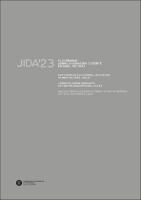Por favor, use este identificador para citar o enlazar este ítem:
https://repositorio.usj.es/handle/123456789/1019
Registro completo de metadatos
| Campo DC | Valor | Lengua/Idioma |
|---|---|---|
| dc.contributor.author | Grávalos Lacambra, Ignacio | - |
| dc.date.accessioned | 2023-11-29T08:15:52Z | - |
| dc.date.available | 2023-11-29T08:15:52Z | - |
| dc.date.issued | 2023-11 | - |
| dc.identifier.citation | Grávalo-Lacambra, Ignacio. El proceso gráfico como acto narrativo. "XI Jornadas sobre Innovación Docente en Arquitectura (JIDA'23), Escuela Técnica Superior de Arquitectura de Granada, 16 y 17 de Noviembre de 2013". Barcelona: UPC, 2023. ISSN: 2462-571X, p. 13-24 | en_US |
| dc.identifier.issn | 2462-571X | en_US |
| dc.identifier.uri | https://repositorio.usj.es/handle/123456789/1019 | - |
| dc.description | The innovation practice presented here aims to investigate the creative synergies extracted from the various intersections generated between architecture and literature through its incardination in the teaching field. It is based on the concept of "defamiliarization", in which the introduction of another discipline (literature) interferes in an architectural or design program, trying to trigger creative processes. Through a graphic approach, a relationship is established between the stories of Invisible cities (Calvino, 1972) and their architectural decline, interpreted under the leitmotif of “the landscapes of abandonment”. The development of the exercises, raised with a high degree of indeterminacy, seeks not only to provide the student with design tools but also to consolidate critical judgment and adjust, through the analytical-educational process, the convergences of thought and the graphic method. | en_US |
| dc.description.abstract | La práctica de innovación aquí presentada tiene por objeto indagar en las sinergias creativas extraídas de las diversas intersecciones generadas entre arquitectura y la literatura a través de su incardinación en el ámbito docente. Se basa en el concepto de “desfamiliarización”, en el que la introducción de otra disciplina (la literatura) interfiere en un programa arquitectónico o de diseño, pretendiendo desencadenar procesos creativos. A través de una aproximación gráfica, se establece una relación entre los relatos de Las ciudades invisibles (Calvino, 1972) y su declinación arquitectónica, interpretados bajo el leitmotiv de “los paisajes del abandono”. El desarrollo de los ejercicios, planteados con un alto grado de indeterminación, procura no solo dotar al alumno de herramientas de diseño sino de consolidar el juicio crítico y ajustar, mediante el proceso analítico-educativo, las convergencias del pensamiento y el método gráfico. | en_US |
| dc.format.mimetype | application/pdf | en_US |
| dc.language.iso | spa | en_US |
| dc.publisher | Digital Politècnica Oficina de Publicacions | en_US |
| dc.rights | Atribución 4.0 Internacional | * |
| dc.rights.uri | http://creativecommons.org/licenses/by/4.0/ | * |
| dc.subject | Graphic design | en_US |
| dc.subject | Narration | en_US |
| dc.subject | Defamiliarization | en_US |
| dc.subject | Creative processes | en_US |
| dc.subject | Invisible cities | en_US |
| dc.subject | Diseño gráfico | en_US |
| dc.subject | Narración | en_US |
| dc.subject | Desfamiliarización | en_US |
| dc.subject | Procesos creativos | en_US |
| dc.subject | Ciudades invisibles | en_US |
| dc.title | El proceso gráfico como acto narrativo | en_US |
| dc.title.alternative | The graphic process as a narrative act | en_US |
| dc.type | journal article | es_ES |
| dc.identifier.publicationfirstpage | 13 | en_US |
| dc.identifier.publicationlastpage | 24 | en_US |
| dc.rights.accessRights | open access | es_ES |
| Aparece en las colecciones: | Artículos de revistas | |
Ficheros en este ítem:
| Fichero | Descripción | Tamaño | Formato | |
|---|---|---|---|---|
| 2023_jida.pdf | 2,91 MB | Adobe PDF |  Visualizar/Abrir |
Este ítem está sujeto a una licencia Creative Commons Licencia Creative Commons

